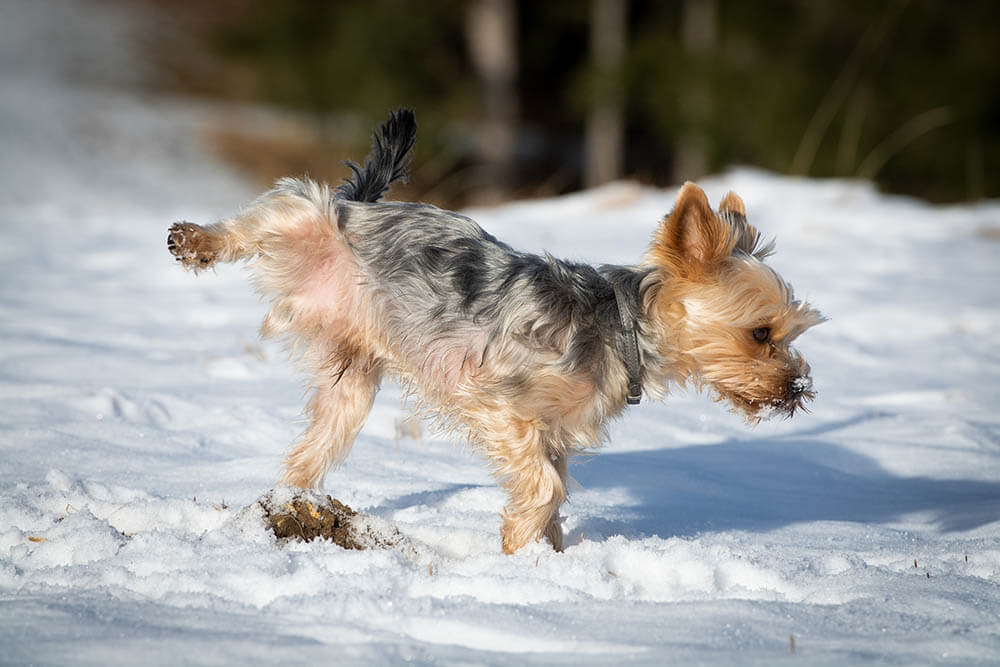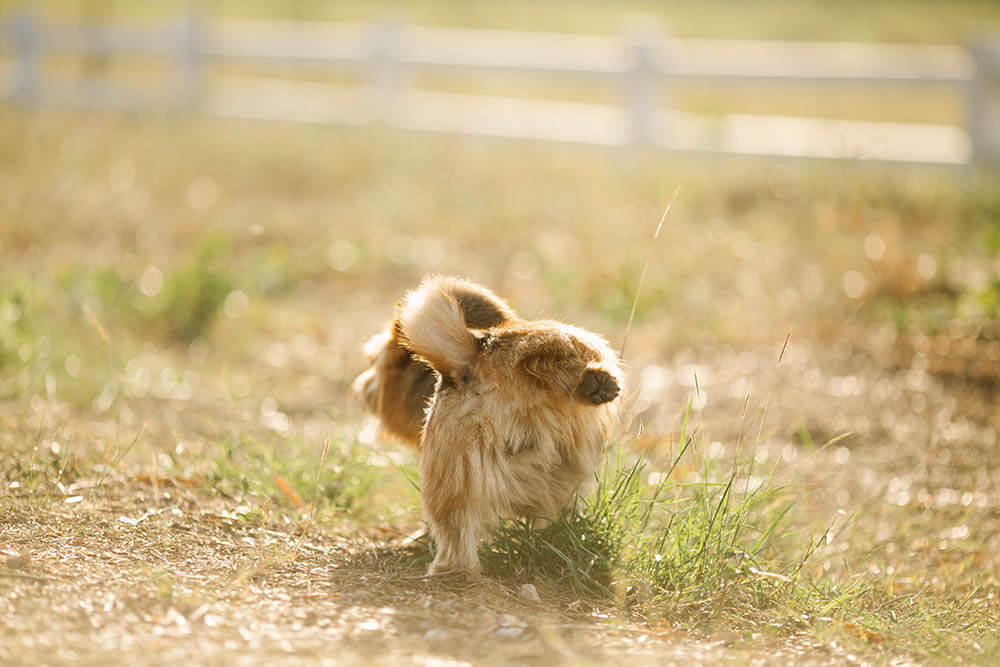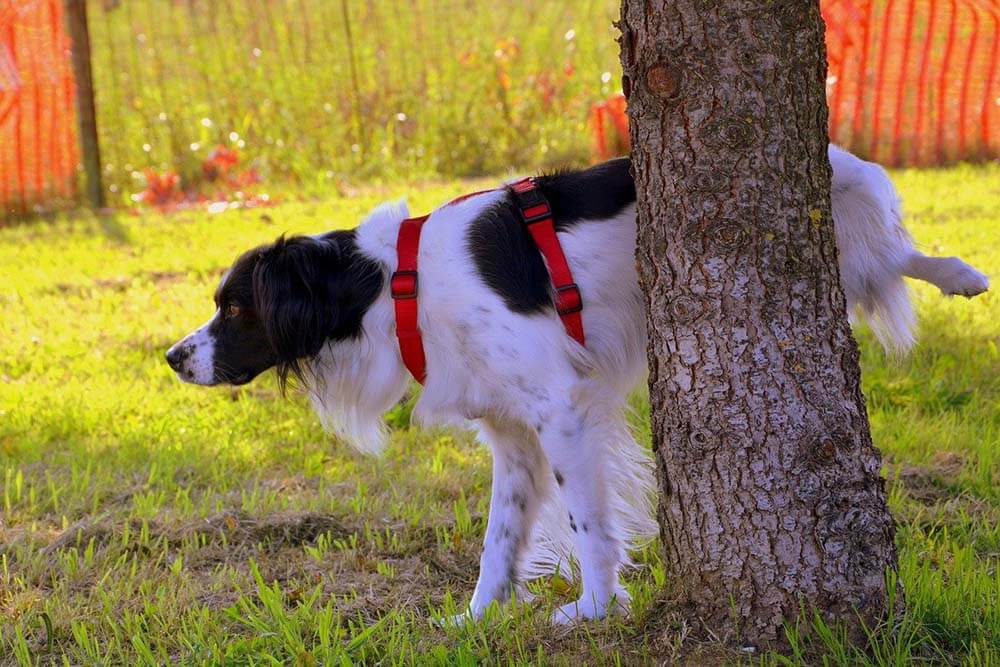There are few activities dogs enjoy more than going on walks. This is because walks allow our canine pals to release pent-up energy, smell a bunch of exciting scents, and find out what’s going on in the neighborhood.
You’ve probably noticed one other thing dogs do on walks: peeing a lot. They’ll pee on the grass, on the sidewalk, on the fire hydrant… they’d probably pee on another person too if such a thing was allowed!
So, what’s up with your dog? Why do they pee so much on walks? Are they broken? Trying to annoy you? Enjoying a life of pure anarchy?
Let’s find out!

3 Normal Reasons Why Your Dog Pees So Much on Walks
In most cases, urinating during walks is natural for dogs. As weird as this habit may seem to us, it can be explained away by the following three extremely normal reasons:
1. They’re marking territory
The marking of territory, or scent marking, is a natural canine instinct that goes back millennia. Canines dribble pee on a spot to mark said spot with their scent, which is their way of telling other creatures, “This is my territory; stay away from it!”
When Rover pees on something (such as a tree or fire hydrant) during his walk, he’s letting other dogs know that he’s been in that location, and he’s claimed it as his territory. At other times, he urinates over a spot another dog has marked in an attempt to steal that territory from that other dog.
Scent marking also allows dogs to learn information about one another. Urine carries with it various details about a dog, such as their health, diet, and stress levels. Think of it like their own form of social media, where the pee a dog leaves is a post about themselves.
In most cases, a dog will mark not one but several spots along their route. This is why they only pee in small amounts; they’re saving up the rest of the urine in their bladders for those other spots.
Male dogs aren’t the only ones who scent mark; females do it all the time, too. Neutering or spaying a dog can reduce this behavior, however.
Should Scent Marking Be Allowed?
Scent marking is not only normal but also important doggy behavior, as it lets them socialize with others of their kind. For this reason, you should let them do it as often as they’d like.
However, make sure your pooch’s peeing habit doesn’t cause anyone any trouble. Urinating on private property – such as someone’s yard or private field – should be avoided at all costs.
2. They’re looking for love
As discussed above, the urine a dog uses to mark a spot is chock full of information about that dog, therefore allowing other canines to know more about them.
When a female dog is in heat, she’ll let every male dog in the neighborhood know that she’s ready to mate. Thus, she pees on several spots during her walk to create a trail leading to her, inviting sexually interested males to find her.
Of course, a female dog in heat could also follow the scent marks left behind by a male. The result is the same: a sexually interested female meets up with a sexually interested male so that they can mate with each other.
This is the canine instinct at work; there’s nothing wrong or unusual about it.
Should Canine Sexual Behavior Be Allowed?
The behavior described above could become a problem if you don’t want your female dog getting pregnant or your male dog impregnating someone else’s pet.
To prevent this scenario, have your pooch neutered or spayed so that they can’t make any babies. Sterilization can also reduce their sex drive, reduce unwanted behaviors stemming from said sex drive, and even help prevent health problems such as certain cancers.
3. They’re excited
Dogs love going out for walks, and sometimes, they get so excited about the activity that they lose control of their bladder.
An extremely excitable pooch could end up peeing every time they encounter something amazing on their walks, like a new dog or old friend, a sight they’ve never seen before, the fragrance of flowers, the wind in their face, and more.

6 Abnormal Reasons Why Your Dog Pees So Much on Walks
Other reasons why your dog frequently urinates on walks are less benign.
If you suspect any of the following is the reason behind your dog’s excessive peeing while outside, seek a veterinarian for help.
1. Aging
On average, healthy adult dogs pee four to six times a day.
As a dog gets older, however, various parts of their body become weaker and less efficient at functioning the way they’re supposed to function. For example, the bladder could end up not working properly, resulting in accidental urination inside and outside the house.
The brain also deteriorates with age, leading to senility. A senile dog could pee yet not realize what they’re doing, thus leading to accidents.
A puppy is also more likely to pee too much as their control over their bladder isn’t as strong as an adult dog’s. In fact, a puppy urinates twice as frequently as mature canines. Thankfully, bladder control improves with maturity.
2. Anxiety, stress, or fear
In dogs, poor mental health can manifest in physical issues, including the inability to control their bladder.
During a walk, a dog can encounter various experiences that can cause them fear, anxiety, or stress. For example, a loud noise can be very frightening for a dog. A strange human or unfriendly animal can make them feel nervous. Whatever the reason behind a dog’s unease, they could end up relieving themselves to alleviate any negative emotions they’re feeling.
Symptoms of anxiety, stress, or fear include frequent, inappropriate urination as well as:
- Licking of the lips
- Scratching
- Yawning
- Excessive panting
- Pacing
- Hiding
- Trembling
- Avoiding eye contact
- Destructive chewing
- Digging
- Running away
- Raised hackles
- Showing the teeth
- Growling
3. Urethra blockage
If a dog has bladder stones, their bladder or urethra could become obstructed by stones. These stones can partially prevent the natural flow of urine, resulting in your dog releasing small amounts of pee intermittently.
A complete blockage can stop your dog’s ability to urinate altogether. As urine accumulates in the bladder, the bladder expands in size until it explodes. This is known as a bladder rupture, which can kill your dog.
Your dog may have bladder stones if they exhibit the following additional symptoms:
- Bloody urine (hematuria)
- Discolored or cloudy urine
- Difficulty urinating (dysuria); your dog may have to strain to pee
- Accidental/inappropriate urination in your house
- Urine with a sharper odor than usual
- Excessive licking of the genital area
- Discomfort in the abdominal or kidney area
- Bloated stomach
- Vomiting
- Decreased appetite
- Lethargy; drop in energy level
- Exercise avoidance

4. Urinary tract infection / bladder infection
A urinary tract infection, or UTI, can cause a dog to pee a lot during a walk. It typically affects older female canines and is usually caused by bacteria in the urethra.
When your dog’s bladder gets infected, they could also experience an increased urge to pee. The infection could even scar their bladder, preventing it from holding urine. Both issues can result in your pooch peeing in inappropriate places, such as inside the house or in various spots along their walking route.
How do you know if your dog’s frequent peeing habit is caused by a UTI or bladder infection? Look for the following additional symptoms:
- Straining to urinate
- Increased urination frequency
- Bloody urine
- Strong-smelling or cloudy urine
- Reduced urine quantity
- Whimpering during urination
- Licking the genital region
- Increased thirst
- Lack of energy
- Fever
5. Urinary incontinence
Various issues can cause urinary incontinence, or a lack of control over excretory functions such as peeing.
An ectopic ureter is one of those causes. This is an abnormal urethral opening, which can occur in any dog but especially in females and breeds such as Labrador Retrievers, Golden Retrievers, Siberian Huskies, Welsh Corgis, Miniature Poodles, West Highland White Terriers, Fox Wire-haired Fox Terriers, English Bulldogs, and Newfoundland dogs. A dog with this condition is also more likely to experience a urinary tract infection.
Another type of urinary incontinence is caused by reduced urethral closure pressure, which is typically caused by neurological issues.
Then there’s hormone-responsive incontinence, which happens months or years following the spaying or neutering procedure. It’s more common in female canines and larger dog breeds.
In addition to frequent urination, the following symptoms are indicative of urinary incontinence:
- Dripping urine
- Redness or irritation on the skin due to dripping
- Excessive licking of the genital region
6. Diabetes mellitus
In dogs, diabetes mellitus occurs when the digestive system fails to effectively convert food into energy they can use. It results in low blood sugar, which in turn leads to reduced energy.
There’s no cure for canine diabetes mellitus. However, it can be managed via exercise, medication, and an appropriate diet.
This condition causes increased urination as well as the following symptoms:
- Excessive drinking of water
- Increased or decreased appetite
- Weight loss
- Cloudy eyes
- Recurring or chronic infections (such as urinary and skin infections)

Conclusion
Why does your dog pee so much on walks? It could be because they’re excited, looking for a mate, or marking their territory. These reasons shouldn’t worry you as they’re normal for canines.
However, a dog who pees often during walks may also be suffering from one of several issues, including age-related incontinence, poor mental health, urinary incontinence, urinary or bladder infection, urethra blockage, or diabetes mellitus. To determine whether your pet’s peeing habit is normal or not, monitor them for symptoms of health problems. Don’t hesitate to contact a vet for help if you suspect your dog is suffering from an ailment.
